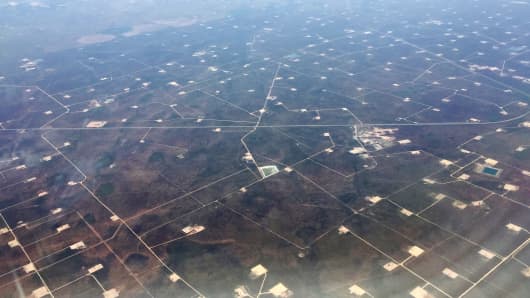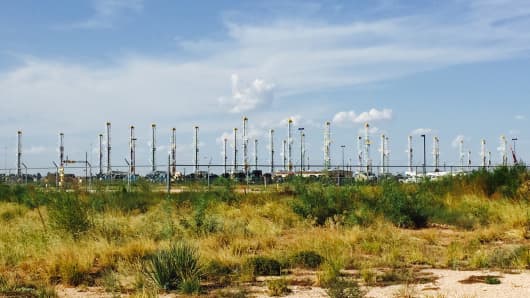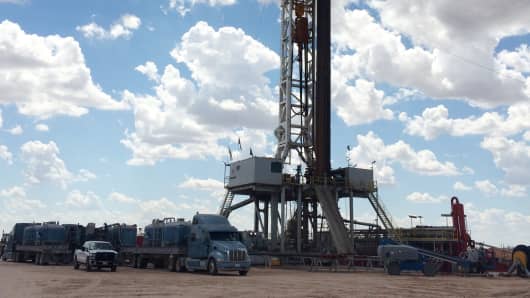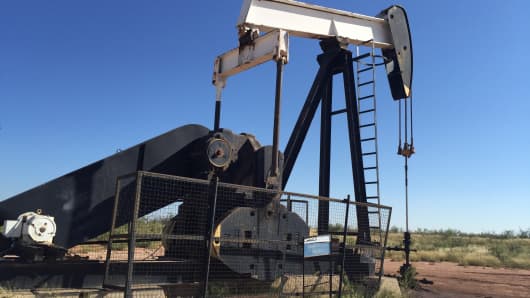The aerial view from a Midland, Texas-bound airplane tells the story: thousands of well pads carved into the desert shrubbery as far as the eye can see.
It's all about oil in West Texas. The area is home to the Permian Basin, the most prolific oil-producing formation in the U.S., a hydrocarbon-rich collection of formations that stretch from Texas into New Mexico. Once written off as a place for tumbleweeds, the area has become a boom region in the past decade as the advent of horizontal hydraulic fracturing—"fracking"—brought new investment to waning, vertically drilled oil fields.
Crude production in the Permian Basin is at near-record levels, around 2 million barrels per day, according to the Energy Information Agency, for the first time since the early 1970s.
But as crude prices have collapsed over the last year amid oversupply and waning global demand, cutbacks have once again starkly taken root in this oil patch, which has experienced boom and bust cycles for nearly a century now. West Texas Intermediate crude was back above $41 a barrel on Thursday but has traded below $40 for much of the week. A year ago, it was above $90.
Read MoreSaudi Arabia hangs on with cheap oil—but for how long?
The rig count has dropped dramatically, down 55 percent since late September, as oil and gas companies drill fewer wells.
"Current prices do not justify continued drilling in the U.S. for oil. Period," said Steven Pruett, chief executive of Elevation Resources, a mid-sized Permian Basin producer backed by private equity.
Elevation, which pumps about 3,000 barrels of oil and 8 million cubic feet of natural gas per day, currently has three drilling rigs running. Two came online in June, when oil climbed back above $60, a move that had many in the sector, including the Dallas Federal Reserve, believing the worst was over.
Standing in front of one of those towering rigs, Pruett said the company is already debating whether it will stay in use: "With $40 a barrel, we have to reassess whether we can continue to justify running this drilling rig to drill new wells. It's not very exciting to put $7 million in the ground with the prospect of recovering that $7 million over 50 years."
Read MoreThis country has just speeded up fracking
Seven million dollars is Elevation's estimated cost to bring a new well online, including drilling and fracking.
Roughly 250 rigs are operating in the Permian right now, up from a low of about 230 in June. If oil stays at near-$40 lows, more will come offline. Pruett said he thinks the count could fall below 100, as it did in 2009, the last time crude was cheap.
He isn't alone in that sentiment. Already, one can see nearly 40 inactive rigs sitting quietly in an industrial park outside of Midland, pointing straight up into the sky because there isn't enough room to break them down and store them sideways. Other lots hold other relics of $100 crude.
Some analysts peg the ballpark break-even of pulling oil out of the West Texas ground at $35 to $40, making it one of more cost-effective energy plays in the United States
But Stephen Robertson, vice president of the Permian Basin Petroleum Association, said the break-even point varies greatly from company to company, and from well to well, based in part on timing and the maturity of a given site. The numbers, he and others maintain, are also changing drastically and quickly.
"There are some companies out there that have figured out a way to cut their drilling costs by 50 percent," Robertson said. "While a few months ago, their break-even point may have been one (price), now it's different."
One company taking advantage of lower labor and equipment costs is Midland-based ExL Petroleum. The 10-year-old oil and gas producer sold its assets to another company last year and since then has been sitting on its cash pile, making plans to expand and begin drilling new wells on new land.
"if you've ever been to a casino, there's a $5 table, a $10 table, a $50, and then there's a table behind the glass, but they're all the same game. Whichever table you're playing, the odds—it's the same game," said Doug Robison, president and founding partner of ExL Petroleum. "At $38 a barrel, if the cost has come down, the return is the same. You're not spending as much money, but you're making the same percentage back."
Robison said his privately held company can extract crude for well below $40 a barrel, since his team has waited out the past year for costs to come down. He pointed to the beginning of the "new resource play" in Permian in the early- to mid-2000s, when crude was $25 a barrel, to illustrate what can be done at low prices when costs are inexpensive.
But not everyone in the Permian is faring well in the downturn. From oil and gas companies to municipalities that depend on oil tax revenue to Wall Street firms that issued debt to drillers, many parties are watching the Permian Basin's players—especially smaller, newer ones—closely.
Larger, more cash-flush players are already quietly gobbling up assets from smaller, private, harder-hit companies that have hedges expiring and debt payments coming due. In many cases, it's not a merger or acquisition, but the sale of operating assets—active wells—that is the focus of deals.
The expectation is that there will be bankruptcies—and if crude stays low, maybe a large number of them. A credit crunch is already beginning to take root as debt payments come due and financiers remain skittish about extending more credit. Many operators have key hedges expiring next year, or for those better-positioned, in 2017. If the Federal Reserve begins raising interest rates, that will take its toll as well—not only making debt more expensive, but likely adding more strength to the dollar, which in turn will continue to weigh on commodity prices.
"There are companies that overspent and overcapitalized ... when the prices were high, (and) they may be in some jeopardy," Robison said. "We'll see some companies go under, and that will create opportunities for others. It's the law of the jungle."
A lot depends on how long low oil prices last.
Production has continued to tick higher as rigs have come offline because once a well is drilled, that particular piece of equipment is no longer needed for further production out of the well. And for companies facing a credit crunch, the only option is to keep running those wells, even at slashed prices.
Therefore, there's a lag time between a collapse in crude prices and a cutback in production. Elevation Resources' Pruett said it's about six months. He expects U.S. overall production to slow through the rest of the year, with a decrease of as much as 1 million barrels per day in early 2016.
Added Robison: "For us, it's going to be a time of being as efficient as possible—to make sure that we perform at the wellhead ... and be as smart as we possibly can on our expenditures. If we do that, we should be successful, because there's going to be an energy industry."
"We have to have it," he said. "It's like farming. You have to have food. You have to have energy."
—CNBC's Justin Solomon contributed to this report.






